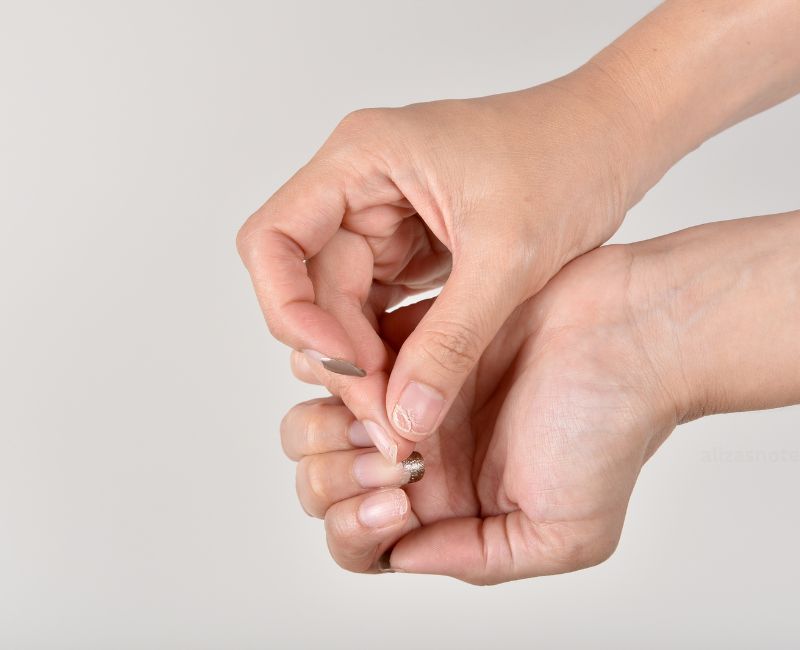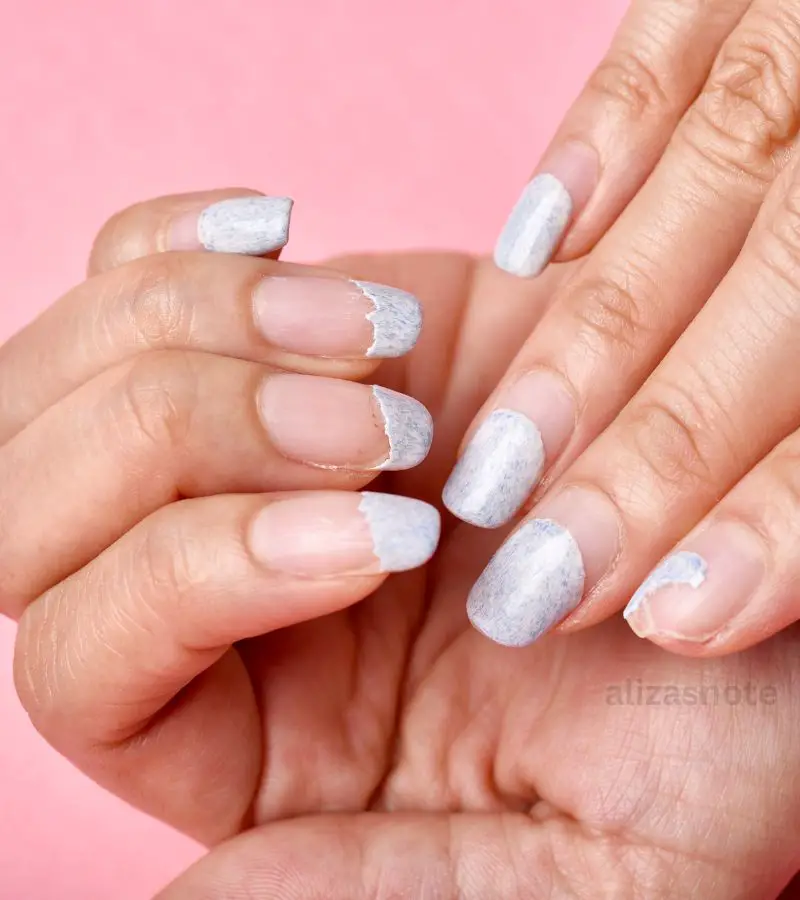Knowing How to fix a broken nail until it grows out is essential for anyone who loves keeping their nails in top shape.
We’ll also share tips on preventing future breaks and maintaining strong, healthy nails.
By this blog post, you’ll be equipped with the knowledge and tools to handle a broken nail like a pro, ensuring that a minor mishap doesn’t become a major inconvenience.
Causes for Broken Nails:
Broken nails can be frustrating and painful. Concerning common causes of nail breakage, you can take steps to prevent it and maintain strong, healthy nails. Here are some key factors:
1. Dryness and Dehydration
- Lack of Moisture: Just like skin, nails need moisture to stay flexible and strong. Dry nails become brittle and are more likely to crack.
- Environmental Factors: Exposure to cold weather, frequent washing, and harsh chemicals can strip moisture from your nails, leading to dryness and breakage.
2. Physical Trauma
- Impact and Injury: Accidental bumps, knocks, or direct impacts can cause nails to break or split.
- Nail Biting: Habitual nail biting weakens the nail structure, making it more prone to breaking.
3. Weak Nail Structure
- Genetics: Some people naturally have softer, weaker nails that are more prone to breakage.
- Health Conditions: Conditions like anemia, thyroid disorders, and psoriasis can affect nail health and strength.
4. Improper Nail Care
- Over-filing: Filing nails too aggressively or in the wrong direction can weaken the edges and cause breakage.
- Improper Cutting: Cutting nails too short or with dull tools can lead to splits and breaks.
5. Harsh Chemicals
- Cleaning Products: Frequent exposure to household cleaning products without protective gloves can damage nails.
- Nail Products: Acetone-based nail polish removers and harsh nail treatments can weaken nails over time.
6. Nutritional Deficiencies
- Lack of Essential Nutrients: Deficiencies in vitamins and minerals like biotin, iron, and zinc can affect nail strength and growth.
- Poor Diet: A diet lacking in protein and essential fatty acids can lead to weaker nails.
7. Frequent Use of Nail Enhancements
- Acrylics and Gels: Overuse or improper removal of acrylics and gels can damage the natural nail, leading to breakage.
- Frequent Polishing: Constant application and removal of nail polish can strip nails of their natural oils, causing them to become brittle.
8. Preventive Measures
To prevent broken nails, consider these tips:
- Hydrate: Regularly moisturize your nails and cuticles.
- Protect: Wear gloves when doing household chores or when exposed to harsh chemicals.
- Gentle Care: Practice gentle nail care, avoid aggressive filing, and keep nails at a manageable length.
- Balanced Diet: Maintain a diet rich in vitamins and minerals essential for nail health.
How to fix a broken nail until it grows out:
Broken nails can be a hassle, but you can easily fix them with a few simple steps and everyday items. Here’s a detailed guide to help you repair a broken nail:
A) Materials Needed
- Tea bag
- Clear nail polish or nail glue
- Scissors
- Nail file or buffer
- Tweezers (optional)
- Nail polish remover (optional)
B) Step 1: Preparation
- Clean Your Nail
Remove any nail polish and clean your nail thoroughly with nail polish remover to ensure the surface is free of oils and old polish. This helps the patch adhere better.
- Cut the Tea Bag
Empty a tea bag and cut a small piece of the bag material. The piece should be large enough to cover the break and slightly overlap the surrounding area for better stability.
- Apply Clear Nail Polish or Glue
Apply a thin layer of clear nail polish or nail glue directly over the broken part of the nail. This acts as an adhesive base for the tea bag material.
- Position the Tea Bag Piece
Using tweezers if necessary, carefully place the cut piece of tea bag over the break while the polish or glue is still wet. Ensure it covers the entire broken area and overlaps slightly onto the healthy nail. Smooth out any wrinkles or bubbles with your finger or a tool.
- Seal with Another Layer
Once the tea bag piece is in place, apply another layer of clear nail polish or nail glue over it. This will secure the patch and help it blend with your natural nail. Allow it to dry before proceeding.
- Buff the Surface
After the patch has dried, gently buff the surface with a nail file or buffer to smooth out any rough edges and blend the patch seamlessly with your natural nail.
- Final Coat
Apply a final layer of clear nail polish over the entire nail to seal the patch and give your nail a uniform finish. You can also apply colored nail polish if you prefer to completely hide the patch.
Tips and Tricks:
- Multiple Layers for Strength
For added strength, you can apply multiple layers of tea bag material, repeating the steps of placing and sealing each layer.
- Use Fine Mesh Tea Bags
A tea bag with a fine mesh will blend better with your nail, making the patch less noticeable.
- Protect the Repaired Nail
Avoid using the repaired nail for activities that might stress it, such as opening cans or heavy lifting, until it has grown out sufficiently.
Maintenance and Prevention:
- Regular Care
Keep your nails trimmed and shaped to prevent future breaks. Moisturize your nails and cuticles regularly to maintain their strength and flexibility.
- Protective Measures
Wear gloves when doing household chores or when exposed to harsh chemicals to protect your nails from damage.
With proper care, your nails will remain strong and healthy, reducing the likelihood of future breaks.
Tips for maintaining healthy nails:
Keeping your nails in top condition not only enhances your appearance but also reflects your overall well-being. Here are five essential tips to ensure your nails stay strong:
1. Prioritize Cleanliness and Dryness
Importance: Clean, dry nails prevent the growth of harmful bacteria and fungi, reducing the risk of infections and nail problems.
Implementation: Regularly wash and thoroughly dry your hands and nails, especially after activities like washing dishes or swimming. Use gloves to shield your nails from prolonged exposure to water and chemicals during household chores.
2. Moisturize Regularly
- Importance: Hydrated nails and cuticles are less prone to brittleness, breakage, and hangnails.
- Implementation: Apply a quality hand cream or cuticle oil daily, focusing on massaging the moisturizer into the nail beds and surrounding skin. Look for products containing nourishing ingredients such as vitamin E, jojoba oil, or shea butter for optimal hydration.
3. Trim with Care
- Importance: Proper nail trimming promotes even growth and reduces the risk of breakage and ingrown nails.
- Implementation: Use sharp manicure scissors or clippers to trim your nails straight across, then gently round the tips with a nail file. Avoid cutting nails too short, as this can cause discomfort and increase the likelihood of ingrown nails.
4. Avoid Exposure to Harsh Chemicals
- Importance: Harsh chemicals weaken nails, making them more susceptible to damage and breakage.
- Implementation: Wear protective gloves when handling cleaning products or engaging in activities that involve exposure to chemicals. Opt for acetone-free nail polish removers and limit the use of acrylics or gel nails, which can compromise the health of your natural nails over time.
5. Maintain a Nutrient-Rich Diet
- Importance: A balanced diet rich in essential nutrients supports overall nail health and strength.
- Implementation: Incorporate foods high in biotin, vitamin E, iron, and zinc into your daily meals. Include eggs, nuts, leafy greens, and whole grains to promote nail health. Consider supplementing with a multivitamin or specific nail supplement if your diet lacks these vital nutrients.
Consistent care and attention will not only enhance the appearance of your nails but also contribute to your overall well-being.
Seek Professional Help:
Here’s a guide to recognizing when it’s time to seek assistance from a nail care specialist:
1. Persistent Nail Problems
Persistent issues like frequent breakage, discoloration, or changes in nail texture despite diligent self-care may indicate underlying issues. Consulting a dermatologist or certified nail technician allows for a thorough assessment and personalized treatment recommendations tailored to your specific needs.
2. Severe Nail Damage
In cases of significant nail damage due to trauma, infections, or prolonged use of harsh products, professional assistance is crucial for repair and restoration. Specialists can suggest suitable treatments, including strengthening regimens, professional manicures, or prescribed medications, to rejuvenate damaged nails.
3. Nail Infections
Symptoms such as nail discoloration, thickening, or crumbling, along with signs of infection like redness or swelling, may indicate nail infections requiring prompt attention. Seeking professional diagnosis and treatment from a specialist ensures accurate management, including prescription medications or targeted therapies for fungal or bacterial infections.
4. Ingrown Nails
Recurring or severe ingrown nails, causing discomfort or risk of infection, necessitate professional intervention. Specialists can provide relief through techniques such as nail trimming, avulsion procedures, or minor surgeries, effectively addressing discomfort and preventing future complications.
5. Nail Disorders
Complex conditions like psoriasis, eczema, or nail psoriasis require specialized care from dermatologists or medical professionals with expertise in dermatology and nail disorders. Seeking professional evaluation ensures accurate diagnosis and comprehensive management plans tailored to alleviate discomfort and improve nail health.
Don’t hesitate to seek professional guidance when necessary to maintain optimal nail wellness and beauty.
FAQ | How To Fix A Broken Nail Until It Grows Out
Q. can a broken nail grow out?
Absolutely. Nails continuously grow from their roots, even if they break. The damaged portion gradually regenerates as the nail grows.
Q. will my nail grow back, after being ripped off?
Yes, nails possess impressive regenerative capabilities. Despite being torn off, nails typically grow back over time, though the process may take several weeks to months.
Q. How long does it take for a broken nail to grow back?
The duration varies from person to person. On average, nails grow about 1/8 inch monthly. Therefore, it may take a few months for a completely broken nail to fully regrow.
Q. What can I do to accelerate nail growth?
While you can’t drastically expedite nail growth, maintaining a nutritious diet, preventing nail trauma, and keeping them adequately moisturized can promote optimal growth.
Q. Why do some nails grow faster than others?
Nail growth rates vary due to factors like genetics, age, overall health, and lifestyle. It’s common for nails on different fingers to grow at distinct rates.
Read Others Post: How Long Do Nails Take To Grow
Last Call:
- Regular moisturizing, proper nail trimming, and minimizing exposure to harsh substances are cornerstone habits to adopt.
- While the process may seem lengthy, rest assured that nails possess remarkable regenerative capabilities.
- This guide aims to equip you with the knowledge and skills necessary to effectively address broken nails.
Call to Action:
- Ready to elevate your nail care game? Join on Pinterest.
- Join our newsletter and Equip yourself with the techniques and insights to navigate any nail emergency with confidence.



